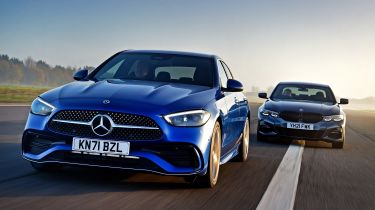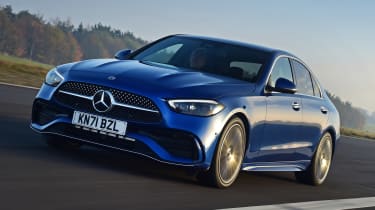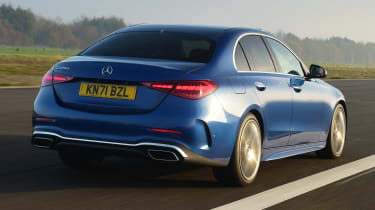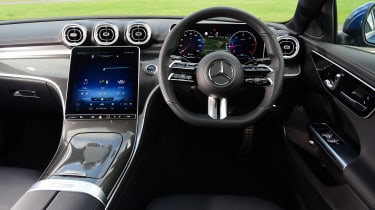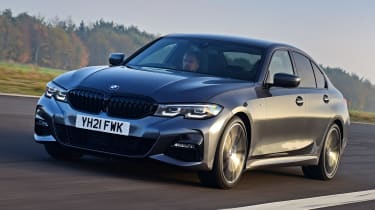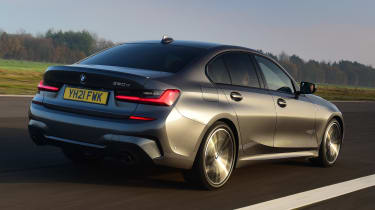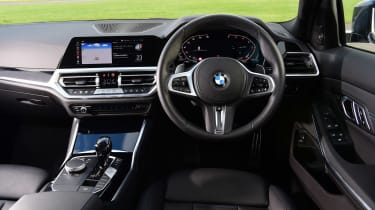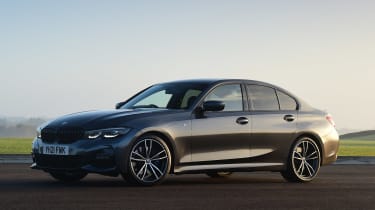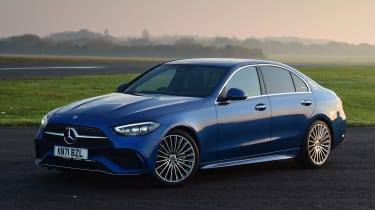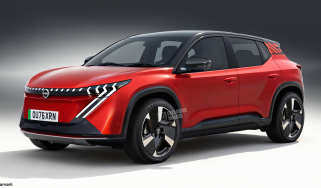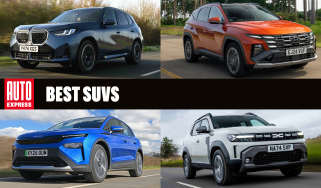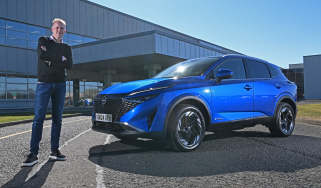Mercedes C-Class vs BMW 3 Series: 2021 group test review
Which diesel compact executive is the best – the new Mercedes C-Class or the BMW 3 Series?
Scroll through the pages of Auto Express, and you could end up concluding that many car manufacturers have given up on traditional bodystyles in favour of SUVs. But one of the last bastions of the conventional low-slung four-door saloon is the compact-executive class.
Sales here remain extremely strong – as challengers from both Mercedes and BMW prove. The previous C-Class became the most popular model in Mercedes’ line-up, with more than 2.5 million (including saloon and estate) sold in seven years. And now there’s a new generation – sleeker, smarter and more efficient than before. But can it fend off its arch-nemesis?
The BMW 3 Series is another hugely popular four-door – indeed, it still jostles among the top 10 best sellers in the UK new-car sales charts. But is that popularity still justified, or has its German counterpart finally put it in its place?
We’ve brought these big-hitters together in diesel form (both boosted by mild-hybrid technology), and their potential for huge ranges between fill-ups makes each of them an ideal motorway cruiser.
Mercedes C-Class
| Model: | Mercedes C 220 d AMG Line Premium |
| Price: | £46,215 |
| Engine: | 2.0-litre 4cyl diesel, 197bhp |
| 0-62mph: | 7.3 seconds |
| Test economy: | 53.6mpg/11.8mpl |
| CO2: | 121g/km |
| Annual road tax: | £155 |
The fight between BMW and Mercedes for compact-executive saloon supremacy continues into another decade – but will the new C-Class overcome its rival? We’ve got the C 220 d here, in AMG Line Premium trim. The only extra fitted to this car is the Spectral Blue paint finish, which adds £685 to the £46,215 on-the-road figure.
Used - available now

2023 Ford
Puma
30,887 milesManualPetrol1.0L
Cash £14,500
2020 BMW
X3
66,781 milesAutomaticDiesel2.0L
Cash £20,787
2023 MINI
Cooper Electric
23,654 milesAutomaticElectric
Cash £13,500
2021 Land Rover
Range Rover
30,552 milesAutomaticDiesel3.0L
Cash £48,500Design & engineering
While the latest C-Class marks an all-new generation and gets a new model code (known internally as W206), it rides on the same Modular Rear Architecture (MRA) platform as before – albeit with extensive updates. The most recent version has grown to 4,793mm long – 65mm longer than the W205, and 84mm more than the BMW. Width is also up by a modest 10mm, while both the wheelbase and track have also increased.
As with its predecessor, there’s a four-link axle at the front and a multi-link set-up at the back. Entry-level models get passive dampers, but the AMG Line cars have an adaptive set-up plus a 15mm drop in ride height. Air suspension is fitted to the rear of plug-in hybrid models.
Every version of the new C-Class powertrain features some form of electrification. The C 300 e mixes four-cylinder petrol power with a 25.4kWh battery for a combined output of 308bhp and roughly 60 miles of electric driving.
We’ve got the more traditional C 220 d diesel here, but even that gets mild-hybrid assistance. In other words, you don’t get the full-electric running that you do in the PHEV, but the small integrated starter/generator unit can reduce load under acceleration and cut out the engine when coasting to improve efficiency. Total output stands at 197bhp, which is backed up by 440Nm of torque.
Perhaps the stand-out feature from the spec list is just how great the difference in kerbweight is between the two cars. The Mercedes tips the scales at a portly 1,755kg – a full 225kg more than the BMW.
Driving
There are many cars in this sector that have traditionally offered a sharper driving experience than the C-Class – and the 3 Series is chief among them. That theme continues with the new model. There’s no disguising the new Mercedes’ weight; turn keenly into a corner, or try to change direction quickly, and it feels lethargic. The body struggles to keep up with the steering – itself a speed-sensitive set-up. The C-Class is secure, predictable and impressively stable at high speeds, but several competitors, chiefly the BMW, are more engaging to drive.
Instead, Mercedes has prioritised comfort, and it’s done a great job. Even on the rather blingy 19-inch alloy wheels of this AMG Line Premium model, the car deals with a variety of poor surfaces admirably well. Knocks from sharp bumps are well isolated from the cabin, and overall it feels like refinement has stepped up marginally over that of the model’s (already relaxing) predecessor.
The stand-out performer in the drivetrain is the gearbox. The nine-speed unit shifts seamlessly and always seems to select the correct ratio. Choose to self-shift, using the wheel-mounted paddles, and it responds quickly, too. The engine itself delivers decent performance, with a smooth response. Only under hard acceleration does any diesel clatter become apparent – and even then it’s subtle.
Practicality
Despite measuring 84mm longer than the BMW, the Mercedes doesn’t manage to offer as much space in the boot; at 455 litres, the overall volume is 25 litres down on that of the 3 Series. It boasts a few practical touches, though; the floor has tethering hooks with which to secure items, and the side recess can easily contain small items thanks to a little net.
While the design of the cabin is something of a revolution, the storage spaces will be largely familiar to any Mercedes owner. The central cubby hidden beneath a small lid has plenty of space for a smartphone, while behind it there’s a double-door armrest bin that’s accessed via a small button.
Those in the back (and their devices) are catered for, too. There are two USB-C ports and a 12-volt socket for recharging smartphones, while the door bins offer a reasonable amount of space for holding a small bottle or similar-sized items.
Ownership
In our latest Driver Power ownership-satisfaction survey, our readers were commenting on the previous C-Class, but the results suggest this Mercedes is likely to deliver a happier long-term experience than its BMW rival.
As a manufacturer, Mercedes ranked 11th out of 29 brands – nearly making it into the top third. BMW’s results were less impressive, reaching only 21st overall. The service its dealers provided scored more positively, ranking 11th out of 21. Once again though, Mercedes scored better, taking ninth spot.
Running costs
During our time with the C-Class, which covered a wide range of driving conditions, it achieved 53.6mpg. That’s still a strong showing, but the 3 Series managed 56.2mpg. The BMW’s higher figure is no doubt in part due to its weight advantage, but also because the C 220 d’s mild-hybrid system isn’t so keen to cut out the engine when coasting or at a standstill. Over the course of 20,000 miles, the 320d would be £177 cheaper to fuel, costing a total of £2,427.
The Mercedes is predicted to hold on to 49.5 per cent of its original value, which is less than the 52.6 per cent BMW owners can enjoy. Both cars are available with three-year service plans that cover maintenance costs through a simple monthly direct debit. At £25 per month, the BMW’s package is £10 per month cheaper than that of the Mercedes.
Testers’ notes: “‘Smart Home’ lets drivers control and monitor their home from their car. Compatible Samsung and Bosch devices include shutters, lights and motion detectors.”
BMW 3 Series
| Model: | BMW 320d M Sport |
| Price: | £40,505 |
| Engine: | 2.0-litre 4cyl turbo, 187bhp |
| 0-62mph: | 6.8 seconds |
| Test economy: | 56.2mpg/12.4mpl |
| CO2: | 122g/km |
| Annual road tax: | £155 |
Few rivals have ever managed to topple the 3 Series from the top of the compact-executive saloon tree, so will the latest C-Class finally wrestle its crown away? We’re testing the BMW here in one of its most affordable forms – before options, at least.
This 320d in M Sport trim starts from £40,505, although the extras added to the car shown in these images – which include the £2,500 M Sport Pro pack, £1,950 Comfort Plus Pack and £1,900 Tech pack – bring the total to £48,005.
Design & engineering
When the seventh-generation 3 Series hit the road back in 2018, it managed to move the game on from its already successful predecessor in several key areas. Central to its improvement in ride, handling, refinement and safety was the introduction of the brand’s Cluster Architecture (CLAR) platform, which makes extensive use of both high-strength steel and aluminium to bolster the structure’s rigidity while also keeping the weight low.
This allows the engine line-up – petrol, diesel and petrol plug-in hybrid – to work at its best. Diesel options come in the form of two four-cylinder units and one six-cylinder, offering between 148bhp and 282bhp. The mid-range 320d seen here makes 187bhp and 400Nm – slightly down on the C 220 d’s figures.
Plug-in power will be the way to go for company car users due to lower Benefit-in-Kind costs, and the 330e blends the potential to run up to 36 miles on electric power alone with a total output of 288bhp. This is the highest figure in the range for any non-high-performance M-badged model.
The purely petrol line-up consists of the 318i, 320i and 330i. All of these models are four-cylinder units that achieve official mpg figures in the low forties, and put out 154bhp, 181bhp and 254bhp respectively.
While the cabin of its Mercedes rival undoubtedly looks more contemporary, there’s very little to choose between the two when it comes to quality. Both feel expensive and well finished – more than a match for any other alternative in the sector. The BMW’s driving position is excellent, with a steering wheel that has plenty of adjustment for reach.
Driving
For a fundamentally fairly standard four-door saloon, where the 3 Series really impresses on the road is just how fun it is. The first difference you notice is that the heavier steering is in contrast to every other aspect of the way the BMW drives; it feels lighter, more responsive and more positive than that of the C-Class.
Whether it’s the engine’s keen reaction to a driver’s throttle inputs, or the way the car turns into a corner – and its willingness to adjust its line while negotiating a turn – the BMW feels more exciting to drive. Where the brake pedal in the Mercedes seems soft at the start of its travel, the BMW’s is sharper and inspires more confidence.
It achieves this without feeling significantly more uncomfortable, too. While the ride from the adaptive dampers becomes appreciably firmer in Sport mode, leave it in Comfort and there’s very little to separate it from the C-Class. Refinement falls ever so slightly short of its rival’s through a combination of just a whisper of extra wind noise and a gearbox that, with one fewer ratio, sits at about 1,750rpm at 70mph in eighth gear, compared with just under 1,500rpm for the Mercedes in ninth.
The transmission in general isn’t quite as uncanny as the smooth-operating nine-speeder. When moving off from a standstill, for example, it’s ever-so-slightly more hesitant to engage. We are nit-picking, though; both of these autos are among the best on the market at the moment.
Practicality
While these sporty-looking compact executives won’t be the first port of call for a family car, both are well set up to cope with everyday life. Isofix child seat fittings are fitted as standard in the back of both models, and they’re similarly easy to get to, with both Mercedes and BMW making the fixings easily accessible behind removable plastic covers.
When you’re loading adults into the back, the BMW proves to be marginally the more spacious car of the two – although there’s just a few millimetres in it. Mercedes has upped the cabin room compared with the C-Class’s predecessor, but it still falls 6mm short of the BMW for headroom and 49mm for shoulder room. Knee room works out to be pretty much a dead heat between the two.
Ownership
Safety body Euro NCAP tested the 3 Series range back in 2019, and the BMW earned the maximum five-star rating. It achieved a perfect score in the lateral-impact test, while its autonomous emergency braking system “avoided collisions in all scenarios” tested.
The C-Class hasn’t been assessed yet, but considering every Mercedes since the Citan Combi back in 2013 has achieved a maximum five-star score – and its models often rank right at the top of their respective classes – we’d expect the new model to perform well. All versions get blind-spot detection, lane-keep assist and an active-braking function that can even swerve to avoid or mitigate a collision.
Running costs
Traditionally, these models have been the prime choice for company car users, but the CO2-based Benefit in Kind calculations mean that both of these diesel saloons are much pricier to run than plug-in hybrid alternatives in their respective model ranges or, for even less taxation, fully electric cars.
Both the 320d and C 220 d fall into the 29 per cent category, and the BMW is the cheaper of the two on account of the lower P11D value of this particular model. That works out at £4,673 versus £5,335.
Testers’ notes: “If you feel the need for a little extra traction, the 320d is available with BMW’s xDrive four-wheel-drive system. It costs an extra £1,500.”
Verdict
First place: BMW 3 Series
The old champion still deserves the top spot here. It continues to offer the best balance between ride and handling in the sector, its cabin has the most intuitive technology, and the build quality remains excellent. What seals it for the 3 Series here, though, is that on a range of lease deals it represents much better value for money than the latest C-Class, too.
Second place: Mercedes C-Class
Make no mistake – the new C-Class is a brilliant car, and only just behind the 3 Series. Cabin space and fuel consumption are closely matched, while it’s slightly more refined, too. The new infotainment system is fantastic, and kit levels are impressive. However, it’s a little too expensive beside the BMW, without offering any significant advantage. Still, it runs its rival very close indeed.
Other options in this category...
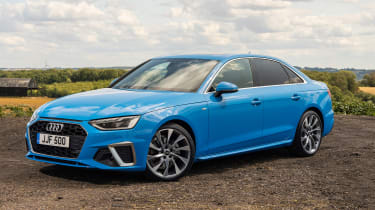
- New: Audi A4 S line 40 TDI Quattro
- Price: £39,950
- Engine: 2.0-litre 4cyl, 201bhp
The other challenger from the German big three remains a deeply appealing proposition. It’s closer to the Mercedes in character, with an emphasis on comfort meaning the A4 is an effortless cruiser. Mild-hybrid tech makes the diesels frugal, while the cabin feels understated yet flawlessly built.
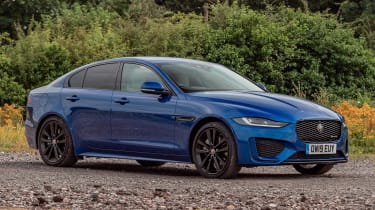
- Model: Jaguar XE R-Dynamic HSE D200 MHEV
- Price: £35,705
- Engine: 2.0-litre 4cyl, 197bhp
While the BMW has always led the way for driving dynamics, the XE pushes it very hard. It can’t quite compete with the Merc’s tech-fest, but recent updates have introduced a brilliant infotainment system. Emissions are a little high, but it’s competitively priced.
Figures
| BMW 320d M Sport | Mercedes C 220 d AMG Line Premium | |
| On the road price/total as tested | £40,505/£48,005 | £46,215/£46,900 |
| Residual value (after 3yrs/36,000) | £21,318/52.6% | £22,895/49.5% |
| Depreciation | £19,187 | £23,320 |
| Annual tax liability std/higher rate | £2,336/£4,673 | £2,667/£5,335 |
| Annual fuel cost (12k/20k miles) | £1,565/£2,608 | £1,527/£2,544 |
| Insurance group/quote/VED | 31/£615/£155 | TBA/£1,098/£155 |
| Cost of 1st/2nd/3rd service | £25 per month (3yr) | £35 per month (3yr) |
| Length/wheelbase | 4,709/2,851mm | 4,793/2,865mm |
| Height/width | 1,435/1,827mm | 1,446/1,820mm |
| Engine | 4cyl in-line/1,995cc | 4cyl in-line/1,993cc |
| Peak power/revs | 187/4,000 bhp/rpm | 197/4,200 bhp/rpm |
| Peak torque/revs | 400/1,750 Nm/rpm | 440/1,800 Nm/rpm |
| Transmission | 8-spd auto/rwd | 9-spd auto/rwd |
| Fuel tank capacity/spare wheel | 59 litres/£190 | 66 litres/repair kit |
| Boot capacity | 480 litres | 455 litres |
| Kerbweight/payload/towing weight | 1,530/630/1,600kg | 1,755/625/1,800kg |
| Turning circle | 11.4 metres | 11.1 metres |
| Basic warranty (miles)/recovery | 3 yrs (60,000)/2 yrs | 3 yrs (unltd)/3 yrs |
| Driver Power manufacturer/dealer pos | 21st/11th | 13th/9th |
| NCAP: Adult/child/ped./assist/stars | 97/87/87/76/5 (’19) | N/A |
| 0-62mph/top speed | 6.8 secs/149mph | 7.3 secs/152mph |
| Auto Express economy/range | 56.2/12.4/679 miles | 53.6/11.8/778 miles |
| WLTP combined | 61.4mpg | 58.9mpg |
| WLTP combined | 13.5mpl | 13.0mpl |
| Actual/claimed CO2/tax bracket | 145/122g/km/29% | 141/121g/km/29% |
| Airbags/Isofix/park sensors/camera | Eight/yes/yes/yes | Yes/yes/F&R/yes |
| Auto box/lane keep/blindspot/AEB | Yes/yes/no/yes | Yes/yes/yes/yes |
| Climate control/cruise control | Yes/yes | Yes/yes |
| Leather/heated seats | Yes/yes | Yes/yes |
| Metallic paint/LED headlights | £695/yes | £685/yes |
| Keyless entry & go/power tailgate | No/£990* | Yes/no |
| Sat-nav/digital dashboard | Yes/yes | Yes/yes |
| DAB radio/connected services | Yes/yes | Yes/yes |
| Wireless charge/CarPlay/Android Auto | £1,900**/yes/yes | Yes/yes/yes |
